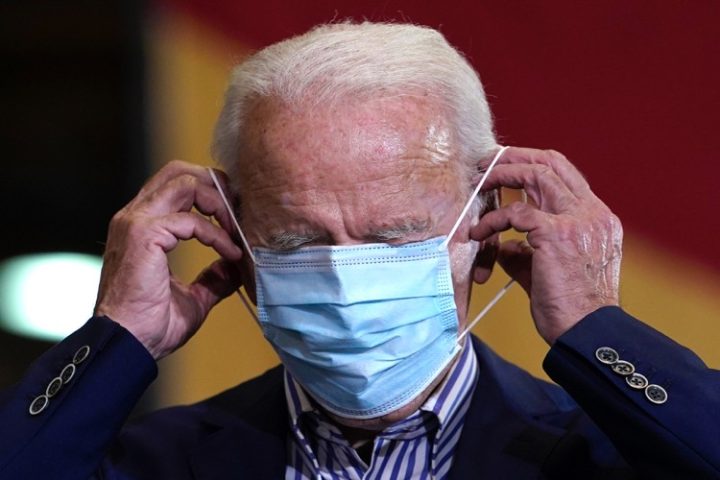
Once again, Democratic presidential candidate Joe Biden has refused to let the American people know if he intends to “pack” the Supreme Court should he win the election in November.
Speaking to some reporters in Phoenix on Thursday, Biden said, “You’ll know my opinion on court-packing when the election is over. It’s a great question, and I don’t blame you for asking. But you know, the moment I answer that question, the headline in every one of your papers will be on the answer to that question.”
As it should be — after all, if Biden intends to support an effort to pack the Supreme Court, the voters should know that before the election, so they can use that information in determining how they will vote.
Biden’s running-mate, Senator Kamala Harris of California, likewise refused to give her view on the issue during her Wednesday night debate with Vice President Mike Pence. Instead, Harris began talking about President Donald Trump’s Supreme Court nominee, Amy Coney Barrett, and meandering off into some remarks about President Abraham Lincoln.
Pence would not be put off so easily, however, and told Harris, “Once again you gave a non-answer; Joe Biden gave a non-answer [in his debate last week with President Trump]. The American people deserve a straight answer. And, if you haven’t figured it out yet, the straight answer is they are going to pack the Supreme court if they somehow win this election.”
Pence tried again. “Are you and Joe Biden going to pack the Supreme Court if Amy Coney Barrett is confirmed? Are you going to pack the court?” He added, “Your party is actually openly advocating adding seats to the Supreme Court, which has had nine seats for 150 years, if you don’t get your way.”
Perhaps the American people do not understand what is meant by “packing” the Supreme Court. What Democratic Party leaders such as Senator Chuck Schumer and Speaker Nancy Pelosi want to do, should Biden be elected president and the Democrats get majority control of the Senate, is to put enough additional justices on the Supreme Court beyond the current nine to make the court a mere rubber stamp of the president and Senate. This court-packing would mean a gutting of the principles of separation of powers and checks and balances, put into the Constitution of the United States by the Founders, as a way of limiting giving too much governmental power to any one person, or any small group of individuals.
This is exactly what President Franklin Roosevelt tried to do in 1937. After winning 46 of 48 states in the presidential election of 1936, and having gigantic majorities in both houses of Congress, he decided he needed to sweep away all opposition to his policies — which meant changing the composition of the Supreme Court more to his liking. The Supreme Court had, by a 9-0 vote, struck down his National Recovery Act as unconstitutional in Schecter v. United States. Some Hungarian Jewish immigrants — the Schecters — who owned a kosher chicken business, had run afoul of the myriad of heavy government regulations of F.D.R.’s National Recovery Administration (NRA). Modeled after Benito Mussolini’s Fascist regulation of the Italian economy, prices, wages, production levels, and working conditions were all dictated by the NRA.
The court had also blocked some other schemes of Roosevelt and his compliant Democrat Congress in his first term, and he was fed up with it.
He called congressional leaders to the White House and essentially demanded that they pass a new law, which would allow him to appoint a new judge for every judge presently on the Supreme Court who was 70 years of age, or older. This would add six new Supreme Court justices, who would be nominated by F.D.R. and, presumably, confirmed by the Senate, which had nearly 80 Democrat members. That way, the legislation that the court had blocked in his first term could then be re-passed in his second term.
As the congressional leaders reached the outside of the White House, one of them said, “Boys, this is where I cash in my chips,” adding that although he had loyally supported Roosevelt thus far, he could not support this. As Rosalie Gordon wrote in Nine Men Against America, Roosevelt “thought he had Congress in the palm of his hand, but his plan was too much” even for a Congress that had been little more than a rubber-stamp.
When the “court-packing plan” of F.D.R. came to a vote in the Senate, it lost 70-20.
The overwhelmingly Democratic-run Senate Judiciary Committee declared, “we would rather have an independent Court, a fearless Court, a Court that will dare to announce its honest opinions in what it believes to be the defense of the liberties of the people, than a court that, out of fear or a sense of obligation to the appointing power, or factional passion, approves any measure we may enact.” The declaration added, “We are not above the Constitution.”
That is what Democratic members of the Senate said in 1937, in rejecting court-packing. Today, however, Biden and Harris are giving every indication that they believe they are above the Constitution. To get this court-packing plan adopted, the Democrats would also need to abolish the filibuster, which Senate Democrat leader Chuck Schumer has given every indication of doing, if that is what it takes to get their way.
While there are many important issues to be decided in this presidential race, this subversive scheme to pack the Supreme Court threatens the very foundations of our political system. Americans have long treasured our constitutional system, with its principles of separation of powers and checks and balances.
Yet, Joe Biden — and his running-mate Kamala Harris — believe you, the voters, do not even deserve to know what they think about gutting those principles. If Biden and Harris were to somehow win the election, and bring in a Democratic majority Senate and House with them, there is now little doubt that they would immediately begin the dismantling of those two precious constitutional principles.



